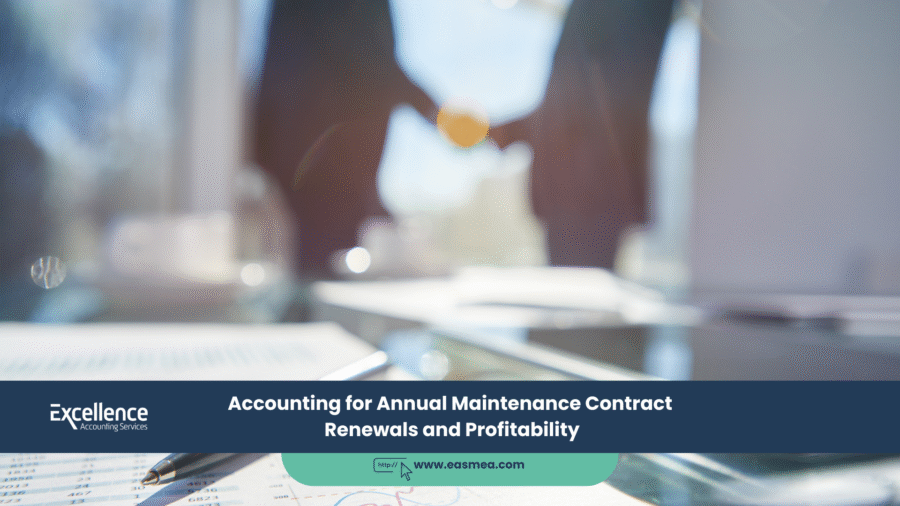Accounting for Annual Maintenance Contract (AMC) Renewals and Profitability
For many businesses in the UAE, particularly in the IT, equipment supply, and real estate sectors, Annual Maintenance Contracts (AMCs) are the bedrock of financial stability. Unlike one-off sales, AMCs provide a predictable, recurring revenue stream that improves cash flow and builds long-term customer relationships. However, this valuable revenue source comes with significant accounting complexities.
- Accounting for Annual Maintenance Contract (AMC) Renewals and Profitability
- The Core Principle: IFRS 15 and Deferred Revenue
- Beyond Revenue: Calculating True AMC Profitability
- Navigating UAE Corporate Tax and VAT
- What Excellence Accounting Services (EAS) Can Offer
- Frequently Asked Questions (FAQs)
- Unlock Your Recurring Revenue.
Properly accounting for AMCs is not as simple as booking revenue when a customer pays. International Financial Reporting Standard (IFRS) 15, “Revenue from Contracts with Customers,” provides a strict framework for how and when this income can be recognized. Furthermore, understanding the true profitability of your AMC portfolio requires a detailed analysis of renewal rates, service costs, and customer lifetime value. Mismanaging AMC accounting can lead to non-compliant financial statements, distorted profitability metrics, and poor strategic decisions.
This guide offers a deep dive into the correct accounting treatment for AMC renewals, profitability analysis, and tax compliance in the UAE. We will break down the principles of deferred revenue, demonstrate how to track associated costs, and provide a framework for measuring the financial health of your service contracts, all while ensuring compliance with UAE Corporate Tax and VAT regulations.
Key Takeaways
- IFRS 15 is Mandatory: AMC revenue cannot be recognized all at once. It must be recorded as “Deferred Revenue” (a liability) and then recognized systematically over the life of the contract.
- Profitability is More Than Revenue: To understand AMC profitability, you must meticulously track direct costs (labor, parts) and allocate indirect costs (overheads, support software).
- Renewal Rate is a Critical KPI: Your AMC renewal rate is a primary indicator of customer satisfaction and future revenue stability. Improving it should be a key business goal.
- Costs to Renew are Expensed: Costs incurred to secure a renewal, such as sales commissions, are generally expensed in the period they are incurred, not capitalized.
- Tax Compliance is Crucial: AMC revenue is subject to UAE Corporate Tax, and the service is generally subject to 5% VAT. Correct accounting is the foundation for accurate tax filing.
The Core Principle: IFRS 15 and Deferred Revenue
The most fundamental rule in AMC accounting is that you earn the revenue as you deliver the service, not when you receive the payment. When a customer pays AED 12,000 for a 12-month AMC upfront, you haven’t earned that money yet; you have an obligation to provide a service for the next year. In accounting terms, this obligation is a liability.
This liability is recorded on the balance sheet in an account called **Deferred Revenue** or **Unearned Revenue**. Each month, as you fulfill one month of your service obligation, you move a portion of that liability to your income statement as earned revenue.
Example: A client renews their AMC on January 1st for AED 12,000 for the year.
- On Jan 1 (Payment Received): The full amount is booked as a liability.
Debit: Cash/Bank AED 12,000 Credit: Deferred Revenue AED 12,000- On Jan 31 (End of Month 1): You recognize one month’s worth of revenue.
Debit: Deferred Revenue AED 1,000 Credit: Service Revenue AED 1,000This process is repeated every month for the entire year. This ensures that your financial reports accurately match revenue to the period in which it was earned.
Beyond Revenue: Calculating True AMC Profitability
Recognizing revenue correctly is only half the battle. To determine if your AMCs are truly profitable, you must track the associated costs with equal diligence. A profitable AMC program requires robust accounting and bookkeeping to capture all expenses.
Key Costs to Track:
- Direct Costs: These are expenses directly tied to fulfilling a specific AMC. This includes the salary/wages of service technicians for the time they spend on a client, the cost of any spare parts or consumables included in the contract, and travel expenses.
- Indirect Costs (Overheads): These are costs that support the entire service department but aren’t tied to one specific contract. This includes salaries of support managers, scheduling staff, the cost of diagnostic software, and an allocation of office rent and utilities for the service department.
- Costs to Acquire/Renew: This includes sales commissions paid to the team for securing the renewal and any marketing costs associated with the renewal campaign.
| Financial Component | Example | How to Measure |
|---|---|---|
| AMC Revenue | AED 24,000 for a 1-year contract. | Recognize AED 2,000 per month. |
| Direct Labor Cost | Technician spends 10 hours/month on the client. | (Technician’s hourly cost) x (Hours spent). |
| Direct Parts Cost | AED 1,200 in spare parts used over the year. | Track parts usage per client; expense AED 100/month. |
| Indirect Cost Allocation | Service department overhead is 20% of direct labor cost. | Allocate a portion of departmental overheads to each contract. |
| Contract Profitability | Revenue – (Direct Costs + Indirect Costs). | Calculate monthly and annually to assess performance. |
A detailed feasibility study or profitability analysis, often part of strategic CFO services, can reveal which contracts are highly profitable and which are underpriced or draining resources.
Navigating UAE Corporate Tax and VAT
The revenue you recognize from AMCs each period contributes to your total income and is subject to UAE Corporate Tax. The costs associated with delivering these AMCs (salaries, parts, commissions) are deductible expenses, reducing your taxable income. Maintaining meticulous records that separate deferred and recognized revenue is non-negotiable for filing an accurate tax return with the Federal Tax Authority (FTA).
For VAT purposes, the provision of a maintenance service is generally a taxable supply subject to the standard 5% rate. VAT should be charged on the full value of the AMC invoice at the time it is issued. Professional VAT consultants can ensure you are managing your VAT obligations correctly, including when and how to report this on your VAT return.
What Excellence Accounting Services (EAS) Can Offer
Maximizing the value of your AMC portfolio requires specialized accounting expertise. At Excellence Accounting Services, we help you transform your recurring revenue stream into a clear, compliant, and highly profitable business unit.
- Accounting System Implementation: We can help you set up your accounting software to automatically manage deferred revenue schedules, ensuring accurate monthly revenue recognition with our system implementation services.
- Profitability Reporting: We go beyond standard bookkeeping to develop custom reports that track the profitability of each AMC, allowing you to make informed decisions on pricing and service levels.
- Account Reconciliation: Our team performs regular reconciliation of your deferred revenue accounts to ensure the liability on your balance sheet is always accurate and auditable.
- Corporate Tax & VAT Filing: We manage your tax compliance from end to end, ensuring your AMC revenue is reported correctly for both Corporate Tax and VAT return filing, protecting you from penalties.
Frequently Asked Questions (FAQs)
The principle remains the same, just extended over a longer period. The entire 3-year payment is booked to Deferred Revenue. You would then recognize 1/36th of the total contract value as revenue each month for 36 months. This correctly reflects the long-term liability and matches revenue to the service period.
The portion of the AMC fee that relates to the service element is recognized over time. The portion related to the parts (a “material right”) is more complex. Under IFRS 15, you may need to allocate a part of the contract value to the potential supply of goods. Often, a simpler approach is to recognize the service revenue monthly and then expense the cost of parts as they are actually used.
Your contract’s terms and conditions are key here. If you provide a pro-rata refund, you would debit Deferred Revenue for the remaining balance, credit Cash for the refund amount, and potentially recognize a small gain or loss on cancellation. If the contract is non-refundable, you may be able to recognize all remaining deferred revenue at the point of cancellation, as your performance obligation has ceased.
Under IFRS 15, costs to obtain a contract that are incremental (i.e., you wouldn’t have incurred them if the contract wasn’t signed) should be capitalized as an asset and amortized over the contract term. However, for simplicity and practicality, especially for one-year contracts, most companies expense renewal commissions in the period they are incurred.
This is a bundled sale. You cannot simply apply the discount to the AMC. You must allocate the total transaction price (equipment + discounted AMC) between the two performance obligations (the equipment and the service) based on their standalone selling prices. This usually results in allocating some of the “discount” to the equipment, leading to slightly less revenue recognized upfront and more revenue deferred for the AMC.
Improving renewal rates is a business function supported by accounting data. Key strategies include: providing excellent service, using a CRM to track renewal dates and automate reminders, analyzing churn data to see why customers leave, and offering incentives for early or multi-year renewals. Accurate profitability data from your accounting system can help you decide how much you can afford to spend on these incentives.
A standard warranty (assurance-type) guarantees the product meets agreed-upon specifications and is part of the product’s cost, with a provision for future repair costs expensed at the time of sale. An AMC (service-type warranty) is a separate service sold to the customer, providing services *beyond* the standard assurance. Its revenue must be deferred and recognized over time, as it is a separate performance obligation.
If the service obligation is based on usage (e.g., 10 support tickets per year), revenue recognition should ideally follow that usage pattern. You would recognize a portion of the revenue each time a ticket is used. However, if there’s no clear usage pattern, a straight-line monthly recognition is often still the most practical and accepted method.
The cost of subcontractors is a direct cost of fulfilling your contract. This cost should be expensed in the same period that you recognize the related revenue. For example, if a subcontractor performs a quarterly service, you would expense their fee in that quarter, matching it against the revenue you recognized over those three months.
A strong, profitable, and well-documented portfolio of recurring revenue from AMCs significantly increases a company’s valuation. Investors and potential buyers see recurring revenue as more stable and predictable than one-off sales. A high renewal rate and clear profitability per contract, demonstrated through professional business valuation and due diligence reports, can command a much higher multiple. Proper accounting is essential to prove this value.
Conclusion: From Liability to Valuable Asset
Annual Maintenance Contracts are far more than just a line item on an invoice; they are a strategic asset that builds predictable revenue and enhances business valuation. By moving beyond simple cash-based thinking and embracing the principles of accrual accounting under IFRS 15, you can unlock a true understanding of your business’s financial health.
Meticulous tracking of deferred revenue, diligent analysis of service costs, and a strategic focus on renewal rates will transform your AMC portfolio from a complex accounting liability into a powerful, profitable engine for sustainable growth.
Unlock Your Recurring Revenue.
Let Excellence Accounting Services provide the expert financial oversight to manage your deferred revenue, analyze profitability, and ensure full tax compliance.




